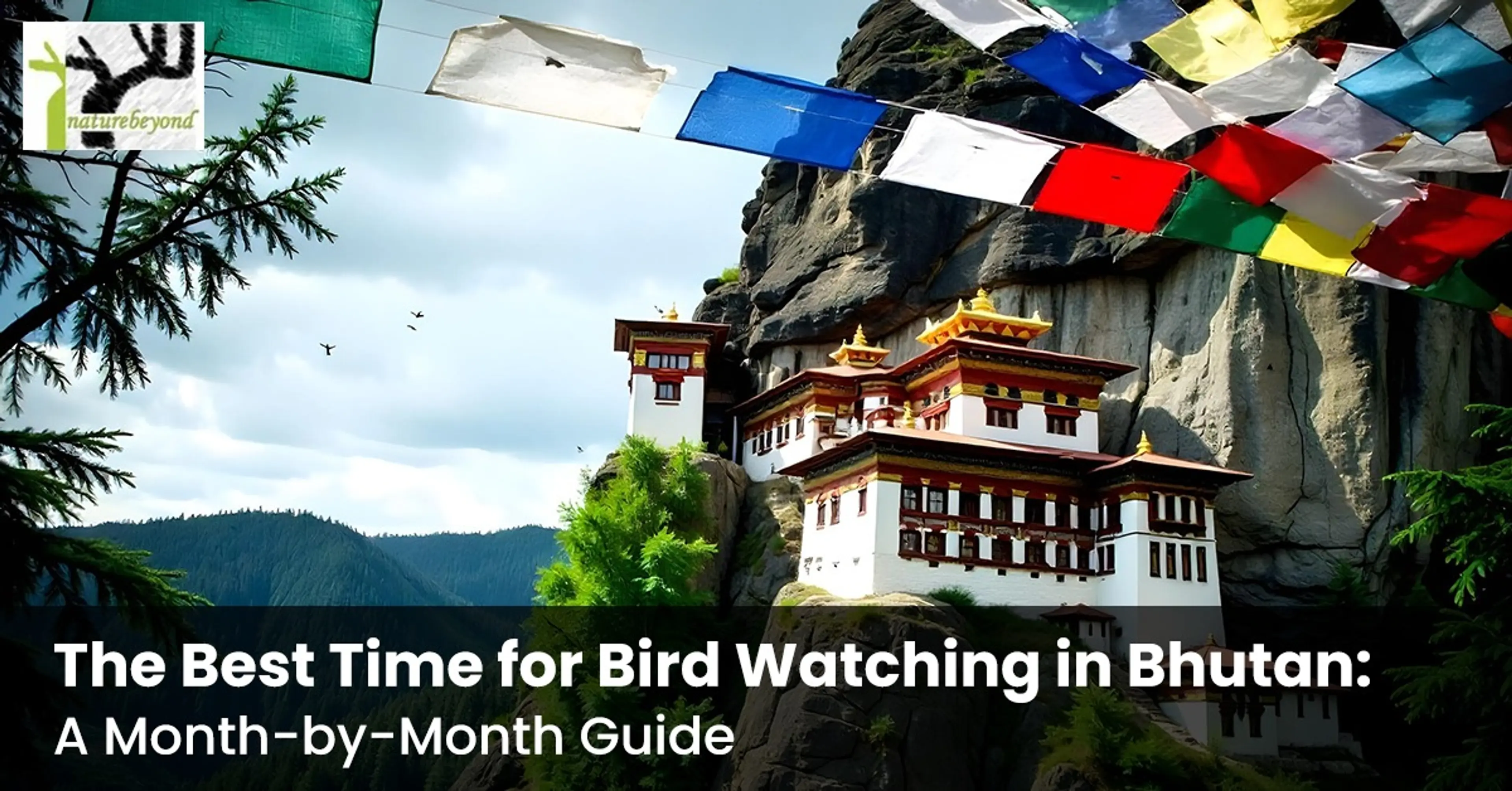
Bhutan is home to over 700 bird species, from the jewel-toned Himalayan Monal (Lophophorus impejanus) to the rare Ward’s Trogon (Harpactes wardi). The country’s mix of subtropical valleys and high mountain passes creates varied habitats, making it a year-round birding destination. But timing your trip can make the difference between spotting a Satyr Tragopan in full breeding plumage or missing it entirely. This guide breaks down Bhutan’s birding calendar month by month, so you can plan your journey for the sightings you’re after.
Bird Watching Seasons in Bhutan (Overview)
-
Spring (March–May): Breeding season for many species; forests come alive with calls and bright plumage.
-
Summer (June–August): Lush and green but with heavy monsoon rains; birding is possible in low-rainfall pockets.
-
Autumn (September–November): Clear skies, comfortable weather, and the arrival of migratory birds.
-
Winter (December–February): Best for lower-altitude birding and rare winter visitors.
Month-by-Month Bird Watching Guide
January
-
Highlights: Black-necked Crane (Grus nigricollis) in Phobjikha Valley; Eurasian Wigeon (Mareca penelope).
-
Best Locations: Phobjikha Valley, Punakha wetlands.
-
Weather: Cold, especially in higher regions; lower valleys are crisp but pleasant.
-
Tip: Layer up for early mornings and carry a thermos of hot tea.
February
-
Highlights: Continued crane sightings; Rufous-necked Hornbill (Aceros nipalensis) in lowland forests.
-
Best Locations: Zhemgang, Royal Manas National Park.
-
Weather: Clear, dry, excellent visibility.
-
Tip: Great month for combining birding with cultural festivals.
March
-
Highlights: Start of breeding season; Satyr Tragopan (Tragopan satyra) begins courtship displays.
-
Best Locations: Thrumsing La, Bumthang valleys.
-
Weather: Mild days, cool nights.
-
Tip: Arrive early at high passes for pheasant activity.
April
-
Highlights: Peak breeding for Himalayan Monal and Blood Pheasant (Ithaginis cruentus).
-
Best Locations: Chele La Pass, Dochula Pass.
-
Weather: Ideal for trekking; rhododendrons in bloom.
-
Tip: Bring a long lens for canopy birds like Ward’s Trogon.
May
-
Highlights: Warblers, cuckoos, and flycatchers active; vibrant calls fill the forests.
-
Best Locations: Sakteng Wildlife Sanctuary, Bumdeling Wildlife Sanctuary.
-
Weather: Warm; occasional pre-monsoon showers.
-
Tip: Watch for mixed flocks in mid-altitude forests.
June
-
Highlights: Parrotbills and laughingthrushes in lush vegetation.
-
Best Locations: Punakha, lowland river valleys.
-
Weather: Start of monsoon; afternoons often wet.
-
Tip: Bird early in the day; waterproof your gear.
July
-
Highlights: Resident species dominate; good for photography in moody monsoon light.
-
Best Locations: Royal Manas National Park.
-
Weather: Heavy rains; leeches in forested areas.
-
Tip: Wear leech-proof socks.
August
-
Highlights: Post-breeding dispersal; sightings of young birds.
-
Best Locations: Broadleaf forests of southern Bhutan.
-
Weather: Rain continues but starts easing.
-
Tip: Stick to accessible lowland areas.
September
-
Highlights: Migratory raptors and waders begin arriving.
-
Best Locations: Phobjikha, Punakha.
-
Weather: Skies clearing; pleasant temperatures.
-
Tip: Ideal for combining birding with trekking.
October
-
Highlights: Mixed flocks active; sightings of Chestnut-breasted Partridge (Arborophila mandellii).
-
Best Locations: Trongsa, Bumthang.
-
Weather: Clear and sunny.
-
Tip: Excellent month for photographing birds against autumn colors.
November
-
Highlights: Black-necked Cranes return; peak crane festival in Phobjikha.
-
Best Locations: Phobjikha Valley.
-
Weather: Cool and dry.
-
Tip: Book early for festival accommodations.
December
-
Highlights: Winter visitors like Wallcreeper (Tichodroma muraria).
-
Best Locations: Lower valleys like Punakha and Wangdue.
-
Weather: Cold mornings, bright days.
-
Tip: Midday is warmest for birding.
Rare & Endemic Birds to Spot Each Season
-
Spring: Satyr Tragopan, Himalayan Monal, Ward’s Trogon.
-
Summer: Rufous-necked Hornbill, various parrotbills.
-
Autumn: Chestnut-breasted Partridge, migratory raptors.
-
Winter: Black-necked Crane, Wallcreeper.
Weather & Travel Conditions for Birders
Bhutan’s altitudes range from under 200m to over 7,000m. Higher passes like Chele La can be snowbound in winter, while valleys remain accessible year-round. Monsoon months (June–August) bring heavy rain, affecting travel. Always check road conditions, especially for remote birding spots.
Tips for Bird Watching in Bhutan
-
Gear: 8x42 binoculars, long lens camera, waterproof clothing.
-
Local Guides: Vital for locating elusive species and navigating terrain.
-
Ethics: Keep distance, avoid playback calls, stick to trails.
-
Best Time of Day: Early mornings and late afternoons.
How Experience Himalaya Enhances Your Birding Trip
Experience Himalaya crafts custom itineraries for all seasons, pairing you with expert birding guides who know Bhutan’s habitats intimately. From arranging permits to securing stays near top birding spots, we make your trip seamless. Popular packages include our 10-day “Bhutan Birding Trail,” covering hotspots from Paro to Bumthang during peak activity periods.